After every episode of Mr. Robot before this past Wednesday night’s, I ended up asking myself the same question: Is this TV show ripping off all its cinematic influences in order to combine them into something new, or is it just ripping them off?
But after Wednesday’s episode, the series’ most referential yet, I’m starting to think that the show is up to more than just nodding toward the giants on whose shoulders it stands. This time, if you connect the dots between the allusions, they begin to form a bigger picture.
A few recappers noted one or two individual Kubrick references in “eps2.1_k3rnel-pan1c.ksd,” but no one seems to have put them all together, revealing how each of the episode’s three principal storylines echoes a different Kubrick movie.
Eyes Wide Shut
Let’s start with the first Kubrick reference I noticed in the episode:
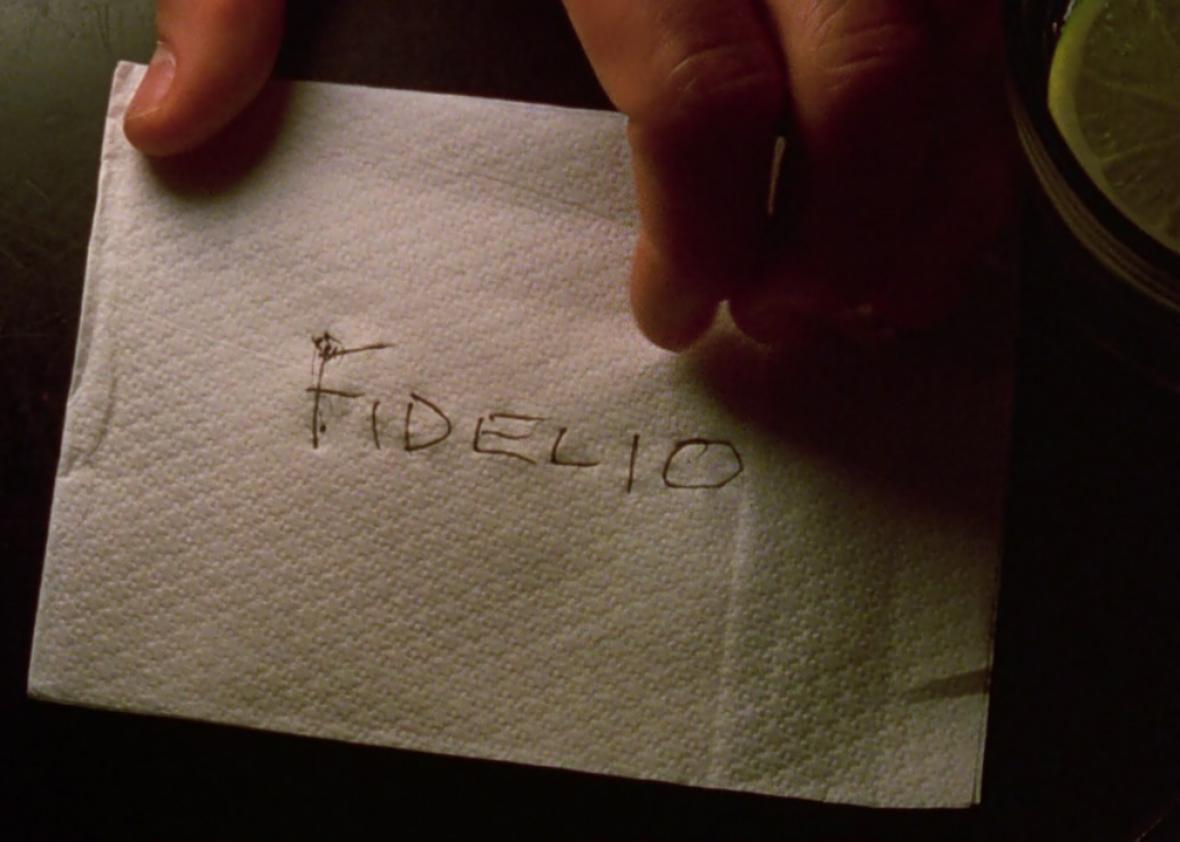
Warner Bros.
Angela’s storyline begins when E Corp CEO Phillip Price propositions her with a mysterious, vaguely sexual invitation: “Have you ever had dinner at Fidelio’s?” Fidelio is the name of Beethoven’s only opera, and it derives from the Latin for faithful, but any Kubrick diehard will recognize it first and foremost as the passcode used to get into the secret gatherings in Eyes Wide Shut. Given the nod, it seems like no coincidence that Angela’s entrance into the restaurant is soundtracked by a song called “Just Say the Word.”
Angela’s plotline also echoes the journey of Tom Cruise’s character in Eyes Wide Shut, Dr. Bill Harford, in other ways. Like Harford, Angela finds herself for the first time infiltrating the luxe lives of shadowy men of power. And as with him, what might have seemed like an erotic encounter becomes nothing but creepy. In each case, the protagonist eventually discovers that the powerful men have conspired together to cover up some nefarious deaths.
Dr. Strangelove
While the Angela plotline echoes Eyes Wide Shut, the Dominique DiPierro (Grace Gummer) plotline echoes Dr. Strangelove or: How I Learned to Stop Worrying and Love the Bomb. This is most obvious when we she unearths the poster for F Society’s “End of the World Party,” which completely rips off a poster design for Dr. Strangelove, and if you look closely, even bears the subtitle “Or How I Stopped Worrying and Learned to Love F Society.”

Still from USA and poster for Dr. Strangelove
In fact, her whole plotline in this episode finds her obsessed—and perhaps vaguely attracted to—the end of the world. She attempts to have cybersex with “happyhardonhenry806,” a man whose priapic moniker is reminiscent of Strangelove’s own “Buck Turgidson.” When she stops, she asks her Amazon Echo, “Alexa, when is the end of the world?”
The Shining
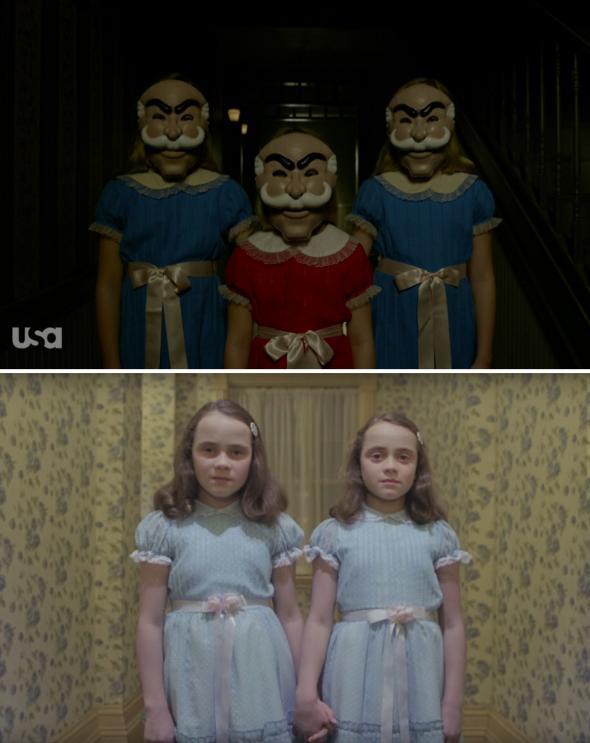
USA and Warner Bros.
Elliot’s plotline is about being cooped up and going mad, so it’s appropriate that it’s packed with references to The Shining. The most obvious one is one of Elliot’s hallucinations, which shows two twins wearing blue dresses with white ribbons. Interestingly, creator Sam Esmail (who also wrote and directed the episode) also tosses in a third girl wearing Kubrick’s favorite color. In fact, there are splashes of the same shade of bright red throughout the episode, which add in a more subliminal way to the Kubrickian feel.
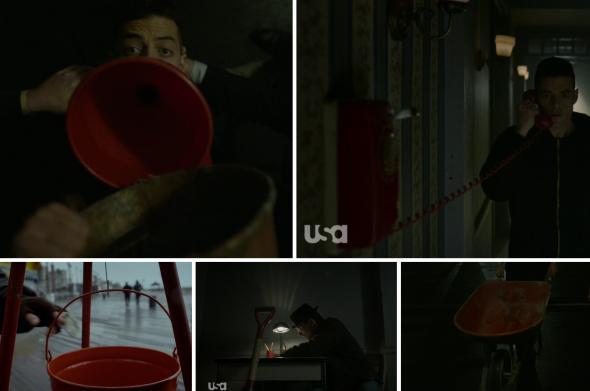
USA
And then there’s Elliot’s attempt to stay sane and avoid relapse by writing in his notebook, which echoes Jack Torrance’s attempts to keep his head and try not to fall off the wagon by working on his manuscript. We were introduced to this coping mechanism in the season premiere, but in this episode it falls apart in rather Shining-esque fashion:
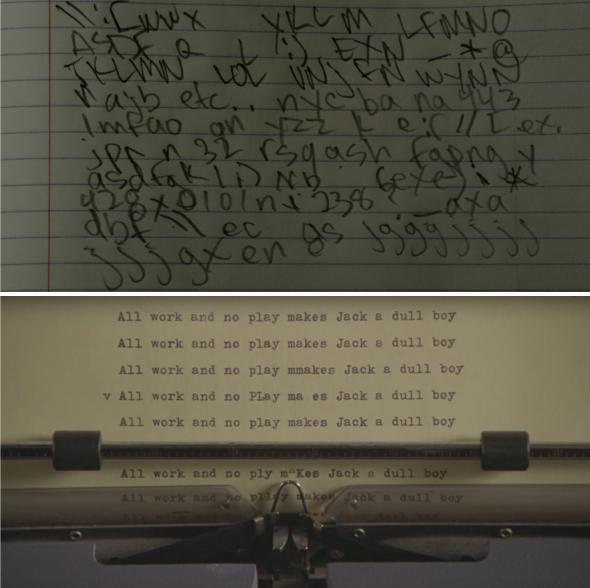
USA
* * *
This is not the first time that Mr. Robot has tipped its cap to Kubrick, of course (nor is Mr. Robot the first TV drama to salute the cinematic master). Esmail has spoken about how he “was doing Kubrick film festivals at my house when I was in high school,” and in an interview with Vulture last year, he spoke about how “one of the biggest influences on the show is Stanley Kubrick in general”:
In terms of Clockwork, the title cards are an inspiration. There are these glasses that I make Darlene [Carly Chaikin] wear that are a little bit of a nod to Lolita. And, actually, it’s not a huge spoiler, but there’ll be a little bit of a nod to Dr. Strangelove in the season finale that people can look out for.
What does this all add up to? I think it has something to do with another recurring theme in the episode: the F-word.
As Slate TV critic Willa Paskin noted in her smart review of the premiere, the second season of Mr. Robot spends a lot of time critiquing itself. With its repeated idle banter about Seinfeld, its disses directed at NCIS (which, as Paskin points out, airs in reruns on USA), and its harrowing depiction of the sheer sadness of watching Vanderpump Rules, Mr. Robot has more and more become a TV show that doesn’t just push the boundaries of television but also draws attention to its limits.
And while regular Slate contributor Sam Adams sees all this episode’s bleeped-out F-words as a symptom of the show’s juvenile attempts to be subversive, I see them differently: as Mr. Robot’s way of highlighting the limits of what you can and can’t say on TV.
After all, “eps2.1_k3rnel-pan1c.ksd” doesn’t just bleep the F-word, it’s largely about censored F-words. Why else would it not only repeat the word so many times but open and close the episode with the origin of the name “F Society”? And soundtrack its main montage with a song by a band called Holy F—? And go out of its way to black out the word on screen, in a manner that makes it look not so much bleeped as redacted?
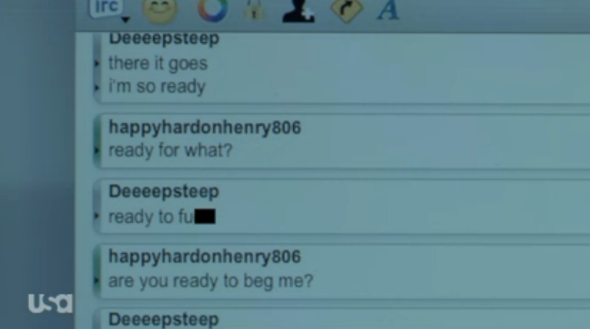
USA
The episode even includes a (censored) F-word in both its final shot and its final line, with DiPierro looking at the sign on F Society headquarters and exclaiming, “You’ve gotta be f—ing kidding me.” You can imagine Esmail wanting to write the word into his screenplay and thinking the same thing.

USA
This surprisingly jokey ending also reminds me of another movie that uses the F-word as its final punchline: Eyes Wide Shut. In the movie’s closing exchange of dialogue, Nicole Kidman’s character tells her husband, “You know, there is something very important we need to do as soon as possible.” When her husband asks, “What’s that?” she responds, “Fuck.”
After pulling off the unlikely feat of putting must-watch prestige television on the USA Network, Esmail has been given more creative control than just about anyone else on television. But while he’s now free to make the show about as cinematic as he wants, he’s still running up against restrictions. After pulling off the nifty trick of changing “Fun Society” to “F Society,” he wants to point out that there’s still at least one thing he can’t say: “Fuck Society.”
